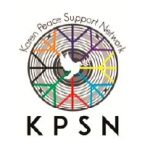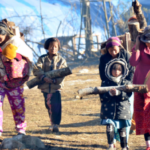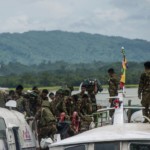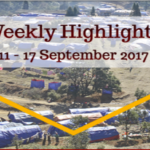By Sai Wansai / Shan Herald Agency for News (SHAN) | March 29, 2018
Recently, United Nations Office for the Coordination of Humanitarian Affairs (OCHA) came up with an approximate figure of 1,900 internally displace persons (IDPs), due to the armed clashes between the Restoration Council of Shan State (RCSS) and the Ta’ang National Liberation Army (TNLA) since 10 March.
The OCHA’s Asia and the Pacific, Weekly Regional Humanitarian Snapshot Report for the period (6 -12 Mar 2018) also stated that a total of 2,500 people have fled fighting in Kyaukme, Namhsan and Namtu townships.
The United Nations estimates that more 15,000 people or IDPs the majority of whom are women and children, remain displaced in camps or camp-like settings in Shan State after fleeing fighting that erupted in 2011, with continued sporadic hostilities between ethnic armies and the Myanmar military or Tatmadaw and different ethnic armed groups further compounding the situation.
While this recent flare up, inter-ethnic conflict, RCSS versus TNLA, has suddenly drawn public attention, including the UN, the Shan IDP, refugee issue is a larger, unresolved problem parallel to the much widely publicized Karen refugee problem numbering some 140,000 and most internationally known Rohingya humanitarian crisis that created 700,000 refugees in just a few months time.
To start with there are six Shan refugee camps in the Thai-Myanmar border. These are Loi Lam, Loi Sarm Sip, Loi Kaw Wan, Loi Tai Leng, Koung Jor, Gawng Mung Mong – which are within Tachileik, Mong Hsat and Larng Khur or Langkho townships in eastern Shan State. There are more than 6200 refugees sheltering in these camps, including 1000 students.
The Shan State Refugee Committee said there are around 300,000 people from over 1400 Shan villages in the whole of the state who fled their homes, between 1996 and 1998, due to clashes between government forces and the armed ethnic group Shan State Army, who sought refuge in these camps.
Between 1991 and 2001 more than 126,000 villagers were moved from six Wa townships from the north to southern Shan State, creating serious hardship and disruption to the area’s mainly Shan, Lahu and Akha communities.
In 2001, fighting erupted between the Shan State Army-South and the Tatmadaw, which was being supported by the United Wa State Army. The Tatmadaw and the United Wa State Army (UWSA) allegedly harassed and persecuted Shan villagers suspected of supporting the Shan State Army-South. Among the thousands of Shan who fled to the Thai border, leaving their villages and property seized by the UWSA, were those who established Loi Kaw Wan IDP camp.
Notably, many of the estimated 1–3 million migrant workers from Myanmar living in Thailand are “unrecognized” ethnic Shan refugees who were displaced by land grabs or environmental degradation connected to development projects.
Thus, the problematic that we are facing is not just a mere few thousands Shan refugees that have fled the civil war but an estimate of a million, which is comparable to the number of Rohingya refugee count that occurred within a time span of a decade. True, the velocity and the short time span that has raised international alarming effect in just a few months reaching some 700,000 to flee to Bangladesh created a disturbing or worrying affect, but the Shan’s slow motion dislocation and dispossession that have spread out during the time span of some three decades doesn’t arouse international attention like the Rohingya crisis.
Present situation
Over 6,200 Shan refugees, who are unable to return home due to regional instability, are facing difficulties after the The Border Consortium (TBC) cut off aids for six Shan refugee camps along the Thai-Myanmar border in October, 2017. The camp committees and civil society organizations are currently supporting the refugees by seeking donations on their own.
So far only a three-member delegation led by Jennifer A.Harhigh, the U.S. Consul General for Chiang Mai, visited Koung-Jor Shan refugee camp in Chiang Mai Province at the Thai-Myanmar border on February 13 to inquire about health, education, and living conditions of the refugees.
“We explained about the difficulties we are facing after the TBC cut off the aids. We told them to urge the U.S. government to provide direct support to the Shan Refugee Assistance Committee instead of providing aids via the TBC if they have a plan to assist the refugees. The delegation took notes,” Sai Leng, who is the camp in charge told the Shan Herald Agency for News.
Repatriation possible?
In line with the TBC strategy for 2017 to 2019 which is focused on supporting the voluntary return, resettlement and reintegration of displaced communities, the aid cuts to all refugees along Thai-Myanmar border came into effect starting last year October. The strategy included building refugees’ self-reliance, autonomy and independence to ensure preparedness when the time comes that they can return home.
“In the context of an ongoing, though still fragile, peace process in Burma/Myanmar, TBC sees itself as moving towards a final phase of operation as an organization,” according to the TBC’s website.
“It further planned the eventual closure of TBC itself, which is planned for a year or two after the closing of most camps,“ the TBC Strategy for 2017-2019 wrote.
The TBC seems to be simply responding to the donor countries wishes which like to speed up repatriation of the refugees and help speed up the peace process, including democratization process.
But as we can see this is now a misplace optimism with the armed conflict between the Ethnic Armed Organizations (EAOs) and the Tatmadaw escalating in Shan and Kachin States, now including and expanding even to the Karen State, threatening to derail the peace process, much less empowering the democratization process.
Statement by Ms. Yanghee Lee, Special Rapporteur on the situation of human rights in Myanmar at the 37th session of the Human Rights Council, 12 March 2018 confirmed the ongoing conflict-affected States of Kachin, Shan and Karen, which she said receive scant international attention, but are having a devastating impact on civilian populations.
The Shan State Refugee Committee released a statement last year in September wrote:
“We cannot yet return to our homes, because our villages are now derelict, or have been occupied by the Burma Army, their militia or the United Wa State Army. Despite the peace process, the Burma Army has expanded its troops, and is continuing to carry out military operations and attacks around our villages. Villagers continue to be arrested, tortured and killed.”
“We want to go home, but even if we do we have no land, it has been taken by the military,” said Sai La Wan, a community leader at Loi Kaw Wan, in an interview late last year.
“Our homes are now occupied by different groups. It would be very difficult to go back; we’d have to buy our own land back,” he stressed.
Besides, the Shans are also threatened by mega-projects like hydro-power dams along Salween River. A massive Mong Ton or Tasang dam to be built by Thailand and China would displace 200,000 to 300,000 people, which affect the areas where the refugees come from, according to Nang Charm Tong, founder of the Shan Women’s Action Network.
“If such projects are built there is no way that the refugees can go back; there is no home for them to return to,” she said during a panel discussion at the Correspondent’s Club of Thailand in Bangkok late last year.
Meanwhile, on March 18, 2018, Burma Army troops from IB 23 shot dead two civilians riding a motorcycle, for no apparent reason, near Wan Shwe Kyaung village, about five miles from the Upper Yeywa dam site in Kyaukme township, northern Shan State. They were identified as Sai Ba, aged 43 and Sai Daw Na, aged 29, according to Shan Human Rights Foundation report of March 26.
Perspective
Firstly, the animosity and armed clashes that have been happening on and off between the RCSS, a signatory of the Nationwide Ceasefire Agreement (NCA), and the Tatmadaw; the periodically flare up of armed engagement between the Shan State Progress Party (SSPP) and Tatmadaw are the first hindrance for the refugees to return.
The United Nations Special Rapporteur on the situation of human rights in Myanmar Yanghee Lee confirmed the ongoing war in Shan and Kachin States, including newly developed clashes between the Karen National Union (KNU), signatory of the NCA, and the Tatmadaw, in Karen State, due to latter’s encroachment on the former’s territories.
Secondly, the problematic of resolving the confiscated land which the refugees are entitled to get back is not clear, including their citizenship rights which still have to be restored.
Thirdly, the angst that comes with the looming large scale investment, including dam building along the Salween river that would be flooded which are the basic to the dislocated Shan’s livelihood.
Like Nang Charm Tong rightly pointed out the majority of the displaced Shans won’t have a place called home to return.
Thus, the precondition of genuine peace without warring groups fighting against each other would need to be first in place. And only after this will the issues of identification process, resolving land ownership dispute and reintegration into the society and so on could follow, not forcefully carrying out the repatriation program as desired by the donor organizations, including some international players who are keen to see the normalization of the country.
This article originally appeared on SHAN on March 29, 2018.







